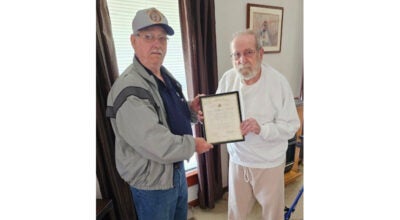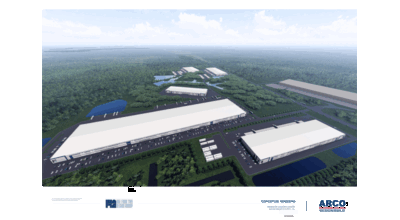Navy looking for airfields for turboprops to practice
Published 8:31 am Wednesday, April 7, 2010
FRANKLIN—The Navy is looking for public or private airfields in southeast Virginia or northeast North Carolina to practice touch-and-go landings for two types of turboprop aircraft.
The Navy is looking for alternative places to land about 50 planes, E-2 Hawkeye and C-2 Greyhound aircraft, some of which are being sent to Florida five to six times a year for the practice landings.
Prospective airfields would need to have a runway at least 5,000 feet in length and 100 feet in width, be able to support a 25,000-pound single gear weight, and be within 90 nautical miles — roughly 103.5 miles — of Naval Station Norfolk, the home base for the planes.
“Any airfield that is interested and meets the requirements would be eligible to participate,” Ted Brown, media relations officer for the Navy’s Fleet Public Affairs Office, said Tuesday.
The Navy could enter into contracts with more than one airfield.
Asked how much one of the contracts with the Navy could be worth, Brown said, “We’re still very early in the process, so that information will be available later as we get farther into it. Obviously that would depend on what the airport was willing and able to support.”
According to data from the Virginia Department of Aviation, eight airfields in the state satisfy the Navy’s runway and proximity requirements, including the international airports at Richmond, Newport News and Norfolk, Emporia-Greensville Regional Airport and Chesapeake Regional Airport. The other facilities are in Chesterfield, Hanover and Accomack counties.
Franklin Municipal Airport, which has a runway that is 4,975 feet long and 100 feet wide, was not included on the list, presumably for not being able to satisfy the 25,000-pound single gear weight requirement. Airport Manager Jimmy Gray said he didn’t know if the runway would meet that requirement.
Data from the North Carolina Department of Transportation indicate at least three airfields in that state — Currituck County Airport, Elizabeth City Regional Airport and Northeastern Regional Airport in Edenton — also meet the Navy’s runway and proximity requirements.
Brown said the E-2 Hawkeye is an aircraft used as an airborne early warning system, while the C-2 Greyhound is used for logistical purposes. The Navy is sending most of the planes to Naval Air Station Jacksonville and Naval Outlying Landing Field Whitehouse in Florida five to six times a year for the practice landings because of capacity issues at Naval Auxiliary Landing Field Fentress in Chesapeake.
“It’s too early to speculate about how (contracts for the E-2 and C-2 landings) would affect the capacity at Fentress,” Brown said. “We don’t know how many, if any, airfields will be willing to contract for the E-2 and C-2 operations, or how many operations they would be willing or able to support. So it’s premature at this time to speculate on how many operations could be conducted at these airfields.”
The Navy was still looking to construct an Outlying Landing Field to support Naval Air Station Oceana somewhere in either Western Tidewater or northeast North Carolina, Brown added. In August, the Navy announced the release of an environmental impact statement over the proposed OLF would be postponed, possibly until the spring, as the Navy decides where to station its new fighter plane, the F-35C Joint Strike Fighter.
“This is being looked at as an interim, near-term solution to our capacity issues at Fentress,” Brown said. “The EIS for the OLF continues. This contract option does not support the purpose and need that we identified in the EIS notice of intent, which is to support all of the field carrier landing practice training for all of the fixed-wing carrier aircraft based at Oceana and (Naval Station Norfolk) Chambers Field.”
Tony Clark, chairman of the group Virginians Against the Outlying Landing Field, said the Navy’s search for other places to land the E-2 and C-2 aircraft shows that the Navy doesn’t really need an OLF after all.
“It proves there are ways to get everybody trained adequately without having to build a new OLF,” Clark said Monday. “While I need more information before I can endorse this move, I think that it’s proof that there are alternatives to confiscating private land and building yet another new military facility when there are plenty of existing assets in place to service the Navy’s aviation needs.”
“If you read between the lines, the Navy is saying that in order to fix the fact that they don’t have an OLF, they are willing to rent an existing landing field to temporarily solve the problem,” Clark continued. “But it doesn’t say that they will still have a capacity problem.”
“This is not about the OLF. The reason why they keep pushing this thing is because their intention is to move Oceana and find a new home for the East Coast Master Jet Base.”
Clark said he believes several airfields could be interested in the Navy’s proposal.
“I think that what you’re going to find is that there are going to be some communities that raise their hands,” he said.
Although the Navy described the turboprop aircraft as “significantly quieter than jet aircraft,” it still plans to submit a request for proposals to airfields interested in the proposal and will analyze the impacts to the airfield, including noise to the community. The timeframe for the project is expected to be about two years.
The OLF would be a practice field where Navy pilots could simulate landings on an aircraft carrier. It would support aircraft squadrons from Oceana and Naval Station Norfolk Chambers Field. The Navy would need to acquire about 30,000 acres for the facility, which would have an 8,000-foot runway.
The Navy has identified five sites, three in Virginia and two in North Carolina, for the proposed OLF. The three Virginia sites are Cabin Point, Dory and Mason. The Cabin Point site is near the confluence of Surry, Prince George and Sussex counties, while the Dory and Mason sites straddle both Sussex and Southampton counties.
In North Carolina, the Sandbanks site is mostly in Gates County, but part of Hertford County would also be affected. The Hale’s Lake site comprises parts of Camden and Currituck counties.





